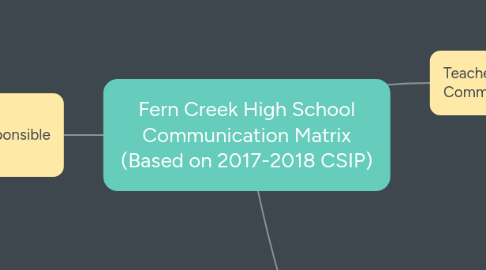
1. Teachers are Responsible for Communicating to:
1.1. Students (Most Common Form of Communication is Individual Advising)
1.1.1. Student Data Notebooks to Track Standards Acquisition
1.1.2. Academic Advising to Discuss Progress Towards Standard Acquisition
1.1.2.1. Additional Time Provided During Class
1.1.3. Grade Level Advisory Sessions
1.1.3.1. Teachers Deliver Lessons Developed in Collaboration w/ CART
1.1.4. Positive Reinforcement System
1.1.4.1. Daily Use of HERO
1.1.5. Behavior Management System
1.1.5.1. Daily Use of HERO
1.1.6. Remind 101, Email, Etc.
1.2. Parents (Most Common Form of Communication is Phone Calls)
1.2.1. Progress Reports
1.2.1.1. Mailed Home Each 6 Weeks
1.2.2. Phone Calls
1.2.2.1. Academic Praise and/or Support
1.2.2.2. Behavior Praise and/or Support
1.2.3. Written
1.2.3.1. Newsletters, Syllabus, Field Trip Permission Slips, etc
1.2.4. Remind 101, Email, Etc.
1.3. Teachers (Most Common Form of Communication is PLC Meetings)
1.3.1. Weekly Formative Assessment Results for Standards Proficiency
1.3.1.1. Delivered Through Weekly PLCs
1.3.2. Assessment Work
1.3.2.1. Teachers Will Meet During PLCs and Data Days to Create Assessments That Effectively Reflect Kentucky Core Academic and CCR Standards
1.3.3. PLC Summer Planning Meeting
1.3.3.1. Writing, Reading, Science, and Math Teachers Will Work as a PLC to Analyze and Embed CCR Standards Into Courses
1.3.4. Vertical Alignment in Math and English
1.3.4.1. Math and English Teachers Meet Once Per Trimester to Discuss Course Alignment
1.4. Administration (Most Common Form of Communication is Small Group Meetings)
1.4.1. Diagnostic Data and Instructional Intervention Strategies
1.4.1.1. Delivered During Data Days Every 6 Weeks
2. Resource Teachers & Administrators are Responsible for Communicating to:
2.1. Students (Most Common Form of Communication is Small Group Meetings)
2.1.1. College Going Culture Student Conferences
2.1.1.1. Delivered by Admin & Support Personnel Each Trimester to Freshman Who Are Failing Classes
2.1.2. Grade Level Advisory Sessions
2.1.2.1. Sessions Developed by College Access Resource Teacher
2.1.3. CLAWS Program
2.1.3.1. Leadership Team Members and Identified Students w/ High Levels of Need (Referred by Counselors or Other Staff) are Paired and Meet Once Per Week
2.1.4. Grade Level Guidance
2.1.4.1. Delivered Monthly by Counselors in Individual Classrooms
2.1.5. Senior Class Visits
2.1.5.1. College Counseling Resource Staff
2.1.6. FAFSA Blitz
2.1.7. Truancy Mentors
2.1.7.1. Weekly Check-Ins w/ Students Who Have Missed 10+ Days
2.1.8. Interventionist Schedule
2.1.8.1. Interventionists Meet w/ 20 Students Per Week to Focus on English & Math Acceleration
2.1.9. Student CCR Plan
2.1.9.1. Students Are Scheduled Into Intervention Based on ACT Scores in Reading, English, and Math
2.1.10. ACT Prep/Boot Camp
2.1.10.1. Extended School Opportunity for ACT Prep (Goal is 100 Students per Week)
2.1.11. College Admissions Counselors
2.1.11.1. Twice Per Month College Admissions Counselors Will Meet w/ Students Interested in Attending College
2.2. Parents (Most Common Form of Communication is Parent Night Meetings)
2.2.1. Adjusted Class Schedules at End of Each Trimester
2.2.1.1. Counselors Will Contact Parents About Each Schedule Change?
2.2.2. Positive Reinforcement System
2.2.2.1. Admins Will Contact Parents About Positive Behavior?
2.2.3. Behavior Management System
2.2.3.1. Admins Will Contact Parents About Negative Behavior?
2.2.4. Behavior Referrals
2.2.5. School Newsletter
2.2.6. CLAWS Program
2.2.6.1. Leadership Team Will Contact Parents of Identified Students After Meeting if Necessary
2.2.7. Principal Advisory Committee
2.2.7.1. Parents and Principal Meet 4 Nights Per Year to Voice Questions and Concerns
2.2.8. Comprehensive School Survey
2.2.9. Parent Nights
2.2.9.1. College and Financial Aid
2.2.9.2. FAFSA Workshops
2.2.9.3. AP Parent Night
2.2.9.4. 8th Grade Open House
2.2.10. Written Letters
2.2.10.1. School Wide Issues, etc.
2.2.11. Crisis Intervention
2.2.11.1. Counseling Recommendations, Centerstone, Suicide Ideation, Threat Assessments, etc.
2.3. Teachers (Most Common Form of Communication is PLC Support and 1 on 1 Mentoring)
2.3.1. Coaching to Individual Teachers
2.3.2. PLC Support
2.3.3. Comprehensive School Survey
2.3.4. College Access Team
2.3.4.1. Team Will Meet Bi-Monthly to Plan and Monitor Progress Towards Increasing the High School Graduation Rate, Decrease Retentions, and Promote College and Career Readiness
3. Students are Responsible for Communicating to:
3.1. Students (Most Common Form of Communication is 1 on 1 Meetings)
3.1.1. Creek Sisters
3.1.1.1. Juniors and Freshman are Paired and Meet 2-3 Times Per Month
3.2. Administration (Most Common Form of Communication is Small Group Meetings)
3.2.1. Student Advisory Committee
